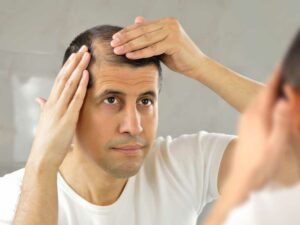Dr. Panagotacos is one of the rare doctors who performs transplants and recommends and prescribes Proscar and Minoxidil 5%. Dr. Panagotacos, thank you for taking the time to answer these questions. I’m sure the viewers of regrowth.com will be thankful.
regrowth: First of all, please tell us about your background. Where did you grow up, go to medical school, and what are your credentials and certifications?
Dr. Panagotacos: I grew up in San Francisco and went to UC Berkeley & University of Oregon as an undergraduate undecided between becoming a college professor and teaching philosophy or zoology. While going for a Masters in zoology, I decided on medicine and went to Georgetown in Washington, D.C.
I got my M.D. degree in 1968; Internship in medicine at St. Mary’s Medical Center 1968-9; 3-year dermatology residency at LSU Charity Hospital, New Orleans 1969-72. US Army Major (Dermatologist) 1972-74. 1974 to Present: Private Practice in San Francisco
regrowth: Would you care to share with us some of your personal interests outside your practice?
Dr. Panagotacos: Personal Interests– What I once would have liked as a vocation (zoology-anthropology-philosophy) I now enjoy as my avocation and have been to Africa 5 times and am trying to help Jean-Pierre Hallet save the remaining pygmies–see www.pygmyfund.org. I read whatever comes my way in these subjects, including science fiction. What I miss most in my busy schedule is having free time to read more. I was the kind of kid who liked to build model planes and read sci-fi. I now enjoy projects such as the recent conversion of a 1953 Triumph Mayflower to an electric automobile, or the recent design and construction of an energy efficient summer home in an isolated area of Greece. Most of all, I enjoy being with my family. I have two grown, married daughters in Southern California, each with two children. I also have a 10-year-old boy who keeps me busy going to baseball and football games. He reads the sports page while I read the comics and Dear Abby. When possible, we like to go snow skiing.
regrowth: I recently had someone ask me about transplant practices in Europe. How do transplant practices in Europe compare to the US? Do they use all the same techniques as their US counterparts? What can you tell us about the transplant business in Europe as compared to the US?
Dr. Panagotacos: They are capable of reading our literature and going to our conferences, therefore, they can be every bit as good as we are here in the U.S. But, the reality is that they do not have good peer review or governmental restrictions, and the very few excellent doctors are hard to find. If I were sick almost anywhere in the world, I would want to come back to the U.S. The same is true for my feelings regarding hair transplantation.
regrowth: How long have you been performing transplant operations specifically?
Dr. Panagotacos: For 29 years. (1969 to present)
regrowth: How long have you been performing scalp reductions?
Dr. Panagotacos: For 20 years. (1977 to Present)
regrowth: How many patients would you say you have performed transplant operations on?
Dr. Panagotacos: Over 10,000 (ten thousand)
regrowth: How many patients would you say you have performed scalp reductions on?
Dr. Panagotacos: Over 1,000 (one thousand).
regrowth: Speaking of scalp reductions, some doctors will not perform them and some places, NHI for example, claim they are unnecessary due to advances in grafting techniques for transplants. Why do you perform scalp reductions and who is right?
Dr. Panagotacos: I am right. It works well for some patients (not all) if done properly.
regrowth: Are there many complications with scalp reduction surgeries?
Dr. Panagotacos: NO. Very rarely, there is an infection or the scar widens.
regrowth: What percentage of your patients who have transplants also have scalp reductions?
Dr. Panagotacos: 10 years ago, 20% of the patients had scalp reductions.
3 years ago, 10% of the patients had scalp reductions.
Today, 5% or less have scalp reductions.
regrowth: How many scalp reductions are usually necessary prior to transplant surgery?
Dr. Panagotacos: When done, on average, 3. An area 1″ wide , perhaps 5″ long, is removed each time. Therefore, if the bald area to be reduced is 3″ in diameter, it is gone in 3 surgeries.
regrowth: How much does it cost to have scalp reduction surgery?
Dr. Panagotacos: $1,800
regrowth: NHI claims that when you perform the scalp reduction that since the scalp is stretched, the amount of hairs available in the donor area is decreased. This seems to make sense. How do you counter their arguments against scalp reductions?
Dr. Panagotacos: The hair you pull up and thin out on the sides looks more normal than the transplants NHI or anyone else could do. You then can transplant over the scar.
regrowth: Are there patients who shouldn’t have scalp reductions and who are they?
Dr. Panagotacos: Those who are too young or are too thin (density)on the sides or whose hairline is too low on the sides. Norwood Type VII
regrowth: Do you think your patients who have both scalp reductions and transplants are more satisfied with their results than patients who only have transplants?
Dr. Panagotacos: I have had both sitting in my waiting room being jealous of the other. (1 session of Extensive Micro- and Mini-grafting vs. multiple procedures of Reductions and Regular Mini & Micro grafting) The one-time micrograft patient was envious of the density that the other patient had acheived with multiple sessions. The patient with multiple procedures was envious of the results that one procedure alone could produce.
regrowth: Do you recommend scalp reductions to patients or just leave it to them as an option and not recommend either way?
Dr. Panagotacos: I ask what their expectations are first, and then advise accordingly, taking into account the extent of baldness, and available donor material.
regrowth: How do you feel about scalp expansions or extensions and why do you not perform them?
Dr. Panagotacos: The added risk, cost, and pain do not justify their use for the vast majority of patients.
regrowth: How do you feel about flap rotation surgeries and why do you not perform them?
Dr. Panagotacos: I have always felt the best flaps were inferior to the best standard grafts and that the worst flaps were much worse than grafts and were a true catastrophe to the patient. Now, with micrografting, ther is even less reason to do a flap.
regrowth: How do you feel about scalp lifts and why do you not perform them?
Dr. Panagotacos: Again: the cost, pain, and risk have led me away from that avenue. However, as done by Dr. Brandy, they can be excellent.
regrowth: On to transplants. First, do you see many women for transplant operations, and is this number increasing?
Dr. Panagotacos: Few, but rising. About 1%.
regrowth: Are women more or less suited to transplants than men?
Dr. Panagotacos: More suited, if you’re referring to thin hair, which can be thickened with micrografts and hidden by styling during the healing process.
regrowth: Have you ever had a female patient who had a scalp reduction and if so how did it turn out?
Dr. Panagotacos: No, and I have never seen one either.
regrowth: We hear so many different terms for grafts from different practices. Which grafts do you perform and please describe them.
Dr. Panagotacos: I do mostly micros and small minis, and only rarely use standard grafts.
1 to 2 hairs = micrografts
3 to 6 hairs = minigrafts
7 to 15 hairs = standard grafts
regrowth: How many grafts or hairs do you transplant in one session?
Dr. Panagotacos: Usually 750 grafts or 2,000 hairs but up to 2,000 grafts or 5,000 hairs.
regrowth: Do you believe in the megasessions method of transplanting large numbers of hairs all in one session?
Dr. Panagotacos: Over 1,500 grafts may tax the scalp’s ability to support the blood supply to the new grafts, therefore I rarely exceed 1,600.
regrowth: How many transplant sessions does your average patient go through?
Dr. Panagotacos: Two.
regrowth: Some practices offer guarantees that their grafts won’t fall out and if they do that they will replace them. Do you offer any such guarantees, and how could you tell if any of your grafts fell out anyway?
Dr. Panagotacos: I don’t have written guarantees, but if any failed to grow I would replace them.
regrowth: Do you have any idea what percentage of your patients would say they are satisfied with their results once they are finished?
Dr. Panagotacos: 99%.
regrowth: Do you ever turn patients down who seem to have psychological problems regarding their hairloss? What percentage of patients are these?
Dr. Panagotacos: Yes. Less than 1%.
regrowth: Do you ever turn patients down just because their amount of loss is too extensive for them to get good results? What percentage of patients?
Dr. Panagotacos: Yes. Less than 3%.
regrowth: Do you ever turn patients down who haven’t lost enough hair yet to know what their final amount of loss will be? What percentage of patients?
Dr. Panagotacos: Yes. 5%.
regrowth: How can a patient know when he has lost enough hair to make transplants worthwhile without worrying about further loss causing poor end results?
Dr. Panagotacos: Talk with a busy doctor with a good reputation. Not a sales person in a clinic. His age and family history also have to be looked into.
regrowth: What general guidelines do you look for to tell if someone has enough hair left to have a transplant?
Dr. Panagotacos: It depends on age, inherited pattern, and expectations. Many have enough donor material to do the front if they leave the back alone.
regrowth: How painful are the shots to the scalp for local anesthetic?
Dr. Panagotacos: Most patients say it is easier than going to the dentist.
regrowth: How noticable is the surgery immediately afterwards? How soon can someone go out in public without it being obvious that they’ve had the surgery?
Dr. Panagotacos: It is very noticeable the first 4 or 5 days. 7 to 10 days later, it is difficult to see. Some of my patients are news anchors and are in front of the TV cameras a week later.
regrowth: How long does it generally take incision scabs to go away?
Dr. Panagotacos: 4 to 6 days.
regrowth: Several people have posted that transplant doctors have told them that transplants would not cause any existing hair to fall out and then it did. Do you warn patients of this and how frequent is it? Are these hairs that have gone into resting phase due to trauma of surgery and will grow back or are they MPB affected hairs that have fallen out early due to surgery and will not grow back?
Dr. Panagotacos: Both a temperary shedding (telogen effluvium) and some permanent loss may occur, therefore it is difficult to predict how much will return. I have all my patients use 5% Minoxidil as a life support system for 6 months.
regrowth: Have you evaluated ProCyte’s GraftCyte’s moist dressings for preventing newly transplanted hairs from falling out and going into resting phase? Have you used them at all and what have been the results? If you haven’t used them do you plan to evaluate them?
Dr. Panagotacos: No. No. I have good results using a very greasy ointment with is OTC, bacitracin ointment. It is the plain vaseline petrolatum which is doing the job to maisturize and speed epidermal cell migration. There are many studies to support this view. The study of GraftCyte vs. plain vaseline petrolatum needs to be done.
regrowth: Do you recommend Proscar and/or Minoxidil to transplant patients?
Dr. Panagotacos: Yes– everyone!!
regrowth: If someone uses Minoxidil and has a transplant session, how soon can they start using Minoxidil again after the surgery?
Dr. Panagotacos: 1 week.
regrowth: Do you recommend any topical treatments such as Iamin or GraftCyte after surgery to promote healing of the grafts?
Dr. Panagotacos: Bacitracin ointment. The patients hate it because it is greasy. However if they had hair transplants done elsewhere first and then follow my post op directions for a week, they are instant converts and begin bringing in their friends. The degree of greasy discomfort in the first 2 or 3 days is directly proportional to how quickly the scalp will heal and look normal.
regrowth: What do you do if a patient comes back to you and is unhappy with their transplant results?
Dr. Panagotacos: I try to correct what it is they are unhappy with.
regrowth: What advances do you see in the future for transplant surgery and how soon do you think they will be available?
Dr. Panagotacos: 1) (coming in 5 to 10 years) cloning. 2) (coming in 5 to 10 years)growing matrix cells and implanting them in tiny holes and waiting for new hairs to grow. 3) (coming in 10 to 15 years) genetic manipulation to prevent and reverse balding without surgeries.
regrowth: What do you say to people who are concerned about the side effects of Proscar, particularly the possibility of effects on unborn children?
Dr. Panagotacos: Proscar may help prevent the formation of Prostatic cancer. Those men with the genetic defect, which proscar is trying to emulate, never go bald and never get cancer of the prostate. The only adverse side effect is a decreased libido in 1 to 2% of those men taking 1 to 5 mg of Finasteride. To me the good effects far outweigh the risks. There is no risk to a developing male fetus unless the pregnant mother is taking Finasteride by mouth herself. She cannot absorb enough through the semen to affect a developing fetus.
regrowth: Do you ever prescribe Proscar to women who are not planning to have children or past their child bearing years? If so, how effective has it been for them?
Dr. Panagotacos: Yes. Very effective in some women, usually with other medications.
regrowth: Have you prescribed Minoxidil 5% to many women and if so how effective was it?
Dr. Panagotacos: Very. Twice as good as 2%.
regrowth: Have you seen any or many women using Minoxidil (2% or 5%) who had the side effect of unwanted facial or body hair growth?
Dr. Panagotacos: Rarely, peach fuzz on cheeks. (less than 1 % )
regrowth: What do you think of the claim of the woman who is suing Upjohn saying Minoxidil caused unwanted facial growth that didn’t go away after treatment was discontinued?
Dr. Panagotacos: I don’t believe her; after 3 months it should have fallen out. She should try Nair.
regrowth: What percentage of patients you prescribe Proscar alone to would you say have regrown enough hair to be cosmetically significant?
Dr. Panagotacos: 40%.
regrowth: What percentage of patients you prescribe your Minoxidil 5% formula to alone would you say have regrown enough hair to be cosmetically significant?
Dr. Panagotacos: 40%.
regrowth: What percentage of patients using both have had cosmetically significant regrowth?
Dr. Panagotacos: 60%. The significant word in the last 3 questions is “regrowth”. Just “stabilizing loss” as a result would double the number of patients who are happy with the results.
regrowth: What is the largest improvement you have seen in someone taking Proscar alone (on the Norwood scale)?
Dr. Panagotacos: Norwood IV –> Norwood III
Savin D6 –> Savin D4
regrowth: What is the largest improvement you have seen in someone using Minoxidil 2% alone (on the Norwood scale)?
Dr. Panagotacos: Little change in Norwood Classification but density on Savin D6 –> D5
regrowth: What is the largest improvement you have seen in someone using Minoxidil 5% alone (on the Norwood scale)?
Dr. Panagotacos: Noorwood type IV Savin D6 density –> Noorwood Type III Savin D4 density
regrowth: Have you ever had patients using Proscar who it was effective for initially but then it lost its effectiveness?
Dr. Panagotacos: NO.
regrowth: Some people have a hard time getting their doctors to prescribe Proscar? How would you recommend someone approach their family doctor or local dermatologist about getting a prescription?
Dr. Panagotacos: The patient could say that he wants to protect his prostate gland with a low dose of Proscar or WAIT another 6 months until Propecia is out.
regrowth: What percentage of your patients using Proscar would you say experience side effects?
Dr. Panagotacos: 1.5%.
regrowth: What percentage of your patients using Proscar who have side effects have them go away?
Dr. Panagotacos: 50%. Some say the side effect of decrease in libido (not total impotence) is outweighed by having more hair.
regrowth: What do you tell people for whom Minoxidil 5% and Proscar is ineffective who don’t wish to have transplants or use a hair system?
Dr. Panagotacos: 1) Balding is a natural process. 2) Some people think bald is beautiful. 3) Many women say they prefer bald men. 4) Think positively. It is a minor cosmetic issue in the overall cosmic scheme of life. 5) I do not hesitate to reccomend a hairpiece if the hair_loss_is a significant problem to the patient.
One of my patients who once wore a hairpiece said he had never met a man who has enjoyed being bald. They may say they like baldness, but if given a chance to have their hair again they would take it. So, despite answers 1-4, many men don’t like being bald and I reccomend option #5.
regrowth: What do you think of Laser hair transplantation? Why do you not perform them? What are the advantages and disadvantages? Is this just a gimmick to get people who think ‘if it’s lasers it must be superior’?
Dr. Panagotacos: It creates dry sockets when it burns a hole into the skin, thereby making it easier to place the new grafts. The crusting lasts for weeks instead of a few days. I cannot bring myself to believe any of the hype no matter how reputable the surgeon saying it. The units are expensive, the surgeons are paid to do the studies and none to date outperform the fine slit technique. The only advantage is to the surgeon, in speed and ease of placing the grafts and perhaps as an advertising gimmick.
Dr. Panagotacos practices in San Francisco, CA. His web site is http://www.hairdoc.com.





